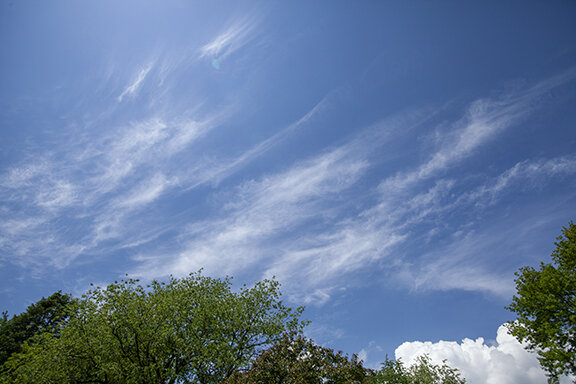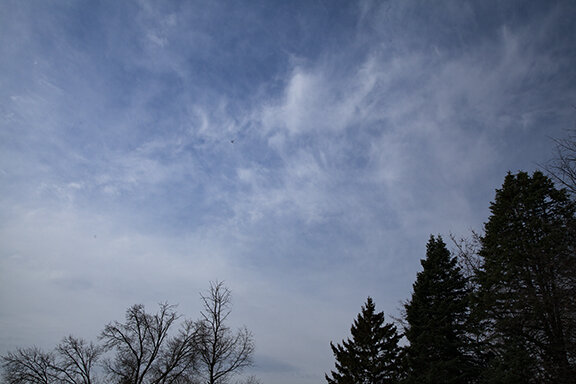Cloud Primary (First) Names
Clouds in the High Cloud family: cirrus, cirrocumulus, and cirrostratus.
The Family of High Clouds
Height: Above 16,500 feet or 5,000 meters
Cirrus
Cirrus often looks like hair. Cirrus are made mostly of ice crystals - even in the summer.
Strong winds blow cirrus into beautiful shapes. Some cirrus are clumps, thick enough to blot out the Sun but most are thin and wispy and allow sunshine to shine through. Cirrus can make halos around the Sun or the Moon.
Cirrus are the highest clouds that are part of our weather. Cirrus can be in streaks or strands, or shaped as small pillows, waves, or in thin flat layers. See examples below.
Wispy with hairlike streaks and strands
Cirrus strands from a thicker cirrus cloud patch
Cirrus in thick clumps with strands and streaks
Cirrus in thick streaks. Cumulus, a puffy or heaped low cloud, are also visible in this photo.
Cirrus streaks are in side-by-side bands in this photo.
Thin cirrus in also in streaks or bands.
Thin Cirrostratus (upper right 2/3rds) with thicker ice crystal streamers falling on the left.
Thin cirrostratus with a spreading contrail (condensation trail from an aircraft)
Thin Cirrus in patches (top) with dense cirrus and cirrostratus (lower half)
Dense Cirrus streamers in a layer
Cirrocumulus bottom, thin cirrus (top) with an isolated patch of thicker altostratus (top center)
Wispy Cirrus (top left) dense cirrus (center) And cirrostratus merging with altostratus (lower left)
Hair-like Cirrus
Wispy Cirrus with thicker clumps
Cirrus above middle clouds (upper right) and cirrostratus and lower altostratus (left half)
Spreading contrails with small lower cumulus in foreground
Thin cirrus with numerous contrails (condensation trails)
Wispy cirrus (upper left) with dense Cirrostratus elsewhere
Cirrocumulus
Cirrocumulus are not visible as often as other cirrus-type clouds. Like other cumulus they are puffy but they look smaller because they are higher and farther away.
Cirrocumulus may look like pillows or small heaped clouds. They are often seen in beautiful patterns with other cirrocumulus. Single cirrocumulus clouds are not seen. Instead look for cirrocumulus in groups of high puffy clouds, often in waves.
Cirrus are ice-crystal clouds but cirrocumulus may also contain water droplets at temperatures down to -40 degrees. Liquid droplet clouds colder than freezing are call super-cooled clouds. Super-cooled clouds are found year around in the middle and higher part of the atmosphere. In winter even low clouds can be super-cooled.
Cirrocumulus shaped like pillows and waves
A close-up of the photo to the left.
MOre waves and pillows mixed with a cirrostratus layer
Cirrostratus
Cirrostratus are mostly smooth sheets or ice crystal clouds in thin layers. Cirrostratus do not block the Sun but the disk may be diffuse. Cirrostratus may be in patches or can overspread the sky. If they spread over the entire sky and lower it means a storm may be approaching.
Cirrostratus with at least 2 contrails. One contrail extends from the bottom to the top of the photo while the other horizontally bisects the photo from left to right.
Dense ciroostratus from an old thunderstorm anvil (flat thunderstorm top). Clumps of cirrus that block the sun’s disk from view are called cirrus spissatus.
Cirrostratus in upper background with lower cumulus in the foreground
Cirrostratus above small lower cumulus in the foreground.
Thin cirrostratus. Notice the almost invisible cirrostratus in the upper left half of the photo. Cirrostratus this thin will usually not be seen at night.
Cirrostratus in background with altocumulus patch right of center
Cirrostratus with a few small cumulus below.
Cirrostratus in the background with altocumulus below in the foreground.






























